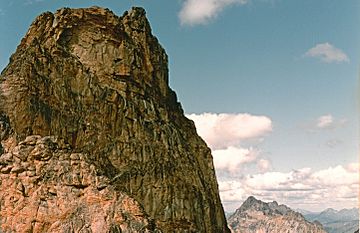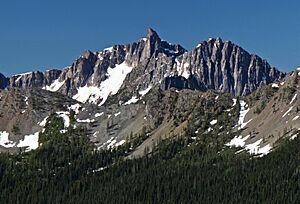Golden Horn (Washington) facts for kids
Quick facts for kids Golden Horn |
|
|---|---|

Golden Horn summit
|
|
| Highest point | |
| Elevation | 8,366 ft (2,550 m) |
| Prominence | 1,126 ft (343 m) |
| Geography | |
| Parent range | Okanogan Range North Cascades |
| Geology | |
| Age of rock | 45 million years old |
| Type of rock | (Rapakivi texture) granite |
| Climbing | |
| First ascent | Fred Beckey in 1946 |
| Easiest route | Climb, class 3 |
Golden Horn is a tall mountain peak in Okanogan County, Washington state. It stands 8,366 feet (about 2,550 meters) high. This mountain is part of the Okanogan Range, which is a smaller section of the larger North Cascades mountain range.
You can find Golden Horn north of Methow Pass, near where the Methow River begins. It's located on land managed by the Okanogan National Forest. The closest mountain that's even taller is Tower Mountain, about 1.67 miles (2.69 km) to the southeast. The first people to climb to the very top of Golden Horn were Fred Beckey, Keith Rankin, and Charles Welsh. They reached the summit on September 18, 1946.
Weather Around Golden Horn
Golden Horn is in a place with a "marine west coast" climate, which means it's near the ocean in western North America. Most of the weather systems start over the Pacific Ocean. They then travel northeast towards the Cascade Mountains.
When these weather systems reach the North Cascades, the tall peaks of the Cascade Range force the air upwards. This makes the air cool down and drop its moisture as rain or snow. This process is called Orographic lift. Because of this, the western side of the North Cascades gets a lot of rain and snow, especially in winter.
During winter, the weather is usually cloudy. But in summer, high-pressure systems over the Pacific Ocean often bring clear skies. Because of the ocean's influence, the snow tends to be wet and heavy. This can make avalanches more likely.
How Golden Horn Was Formed
The North Cascades mountains have very rugged shapes, with sharp peaks, long ridges, and deep valleys carved by glaciers. These different shapes and big changes in height happened because of geological events millions of years ago. These events also led to the different climates you find across the Cascade Range.

The Cascade Mountains started forming millions of years ago, during the late Eocene Epoch. At that time, the North American Plate was slowly moving over the Pacific Plate. This movement caused a lot of volcanic activity. Also, small pieces of the Earth's crust, called terranes, came together to create the North Cascades about 50 million years ago. Like many peaks in the Washington Pass area, Golden Horn is made from a type of granite called Rapakivi texture granite. This rock comes from a large underground rock formation known as the Golden Horn batholith.
During the Pleistocene period, which was over two million years ago, glaciers moved across the land many times. As they moved, they scraped away the landscape and left behind piles of rock. The "U"-shaped valleys you see today were formed by these glaciers. The combination of land being pushed up (called uplift) and cracks in the Earth's crust (called faulting), along with the glaciers, created the tall peaks and deep valleys of the North Cascades area.
More Information
- Golden Horn aerial photo: Pbase.com
- Golden Horn weather: Mountain Forecast




